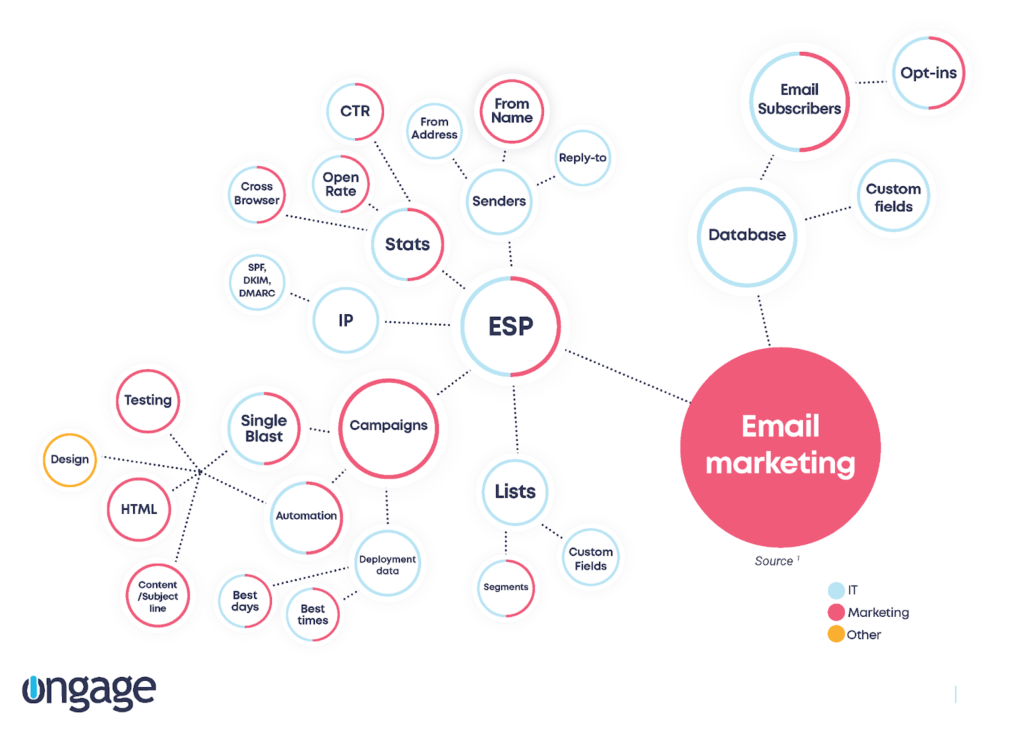The beginning of a new year means fresh starts. It involves examining your overarching strategy and allocating budgets to various departments. Your email operation mustn’t be left behind during these times. An email marketing audit will help you get all of your ducks lined up, understanding and making sense of everything that’s going on in your email department. Here’s how to get it done.
On April 13, 1970, two days after its launch from the Kennedy Space Center, an oxygen tank in the service module for the Apollo 13 space vehicle exploded.
This event meant the end of the planned objective of the mission–to make a moon landing. But with three crew members trapped onboard the damaged craft, Apollo 13 still had another mission to complete.
That mission was a success.
The crew survived the extreme conditions and worked with on-ground teams to find a way home. To accomplish their return to earth, the crew members of Apollo 13 had to bring all their learned and inherent skills and abilities to bear.
The crew not only had to withstand physical hardship but also emotional and cognitive challenges.
Their success was no mere coincidence.
It resulted from rigorous training across multiple disciplines and an astronaut selection process that ensured multi-disciplinary fitness through ongoing testing.
In other words, they underwent astronaut audits.
Audits are how teams assess readiness, confirm skills and capabilities, and identify weaknesses.
These are critical not only for ensuring a program’s success but also for avoiding cataclysmic failures. In fact, it was “a combination of manufacturing and testing errors” that led to the explosion that cut Apollo 13’s journey short, explains Space.com.
The health of your email marketing program may not be a matter of life or death, but auditing your email marketing capabilities and preparedness can make the difference between the success or failure of your email marketing program.
Regularly auditing each element of your email marketing efforts provides you with essential data about your program’s operational status, performance, and vulnerabilities.
Email audits give you the information you need to ensure that your program can meet your business objectives and be prepared to respond to changes in the marketplace. Audit data also enables you to identify points of opportunity and make continuous improvements that help you stay ahead of the competition.
Is your email marketing program ready for orbit? Learn how to audit your email marketing and position your program for maximum performance in this article.
What is an email marketing audit?

An email marketing audit is a formalized review of your email marketing program that examines each of the various components that contribute to the program’s success or failure.
Like a financial or any other audit, an email audit begins with a defined plan and objectives and is a thorough examination of every aspect of your program.
This comprehensive approach distinguishes an audit from a spot check, performance monitoring, or targeted reporting/analysis. You might think of an email audit as the mother of all reviews, the Big Kahuna, the Mars mission.
Why engage in this epic undertaking? And why continue to audit your email marketing program regularly?
Because knowledge is power, and data drives good decisions.
Besides, if you don’t know where you started from, how will you know if you’re making progress?
10 benefits of regularly auditing your email marketing efforts
- Develop a data-guided culture of accountability and continuous improvement across your email marketing team.
- Better align your email marketing program’s objectives with your organization’s business objectives.
- Gain a macro view of your email marketing program’s status and establish benchmarks and relevant, measurable KPIs.
- Formalize and systematize email operations, creating a uniform, repeatable and scalable processes.
- Achieve greater consistency across email and email-adjacent marketing collateral, its branding, messaging, and design.
- Improve productivity and efficiency and reduce errors in executing your email marketing campaigns.
- Enhance your subscribers’ experiences while improving your deliverability and engagement metrics.
- Ensure compliance with privacy and data-protection laws and regulations, building trust and loyalty among your brand’s subscribers (and avoiding fines).
- Manage and mitigate risks. Avoid costly operational or reputational errors–maintaining healthy subscriber relationships and staying off email blocklists.
- Develop actionable insights that facilitate quick wins through immediate fixes and power long-term growth opportunities.
What should be included in a comprehensive email audit?
An email marketing audit actually consists of many audits of parts of your email program that, when combined, gives you a complete picture of your program’s successes and failures, strengths, and weaknesses.
There are different types or categories of email audits that email senders may perform together or separately, depending on the organization’s characteristics and needs. For example, a B2B email marketing audit may incorporate different lead generation and integration checks compared to an ecommerce email marketing audit.
Every email audit should begin with a comprehensive overview.
If you don’t have systems in place to collect the relevant data or fully understand the questions your audits need to answer during your first audit, make a note of what is missing. As your email marketing audit matures, your examinations will yield deeper insights, and the benefits you gain from your audits will grow.
What are the main elements of an email audit?
Before an astronaut is cleared for launch, they must pass several physical tests that ensure they withstand the pressures of space travel and perform during regular and emergency conditions. They must also meet the space program’s education standards and demonstrate critical reasoning skills.
Then the astronaut candidate has to prove their proficiency in flight control and maneuvers. Hopeful astronauts are even evaluated for psychological and emotional resilience. Can they cope with being away from the earth for long periods? How will they react in an emergency?
Every one of these pre-launch checks is essential to ensure that the astronaut is prepared. Yet each one is also a stand-alone indicator of a specific component of the person’s overall health, well-being, knowledge, and capacity.
That’s how the different email audits work together as well.
A review of your email deliverability, infrastructure or engagement status, and performance all produce valuable intel about your program’s health.
A combined audit of these components and the other parts of your email marketing program provides you with a complete condition report that sets the baseline for future evaluations.

Each of the components illustrated in this image clipped from Ongage’s Email Deliverability: The Complete Handbook contributes to the success of your email marketing program.
The types of email audits marketing teams perform may be categorized by the functions or tasks they review, the department or team responsible for the activities, or other attributes that make sense to the organizers.
When auditing your email marketing program, you’ll commonly examine the following categories:
🔦 Infrastructure.
🔦 Technology and integrations.
🔦 Cross-channel integration and performance.
🔦 Data and asset management.
🔦 Reputation and deliverability.
🔦 Contact management or list building and maintenance.
🔦 Compliance.
🔦 Segmentation and personalization.
🔦 Content, copy, and design.
🔦 Workflows or triggered campaigns.
🔦 Performance metrics, email analytics, and reporting.
You may have noticed there’s a lot of room for crossover between these categories.
For example, auditing a program’s drip campaigns will require examining CRM integrations, technology, and performance metrics. An audit of your brand’s deliverability will involve an assessment of its infrastructure and engagement performance.
Also, these categorizations aren’t inflexible.
You may encounter other email audit types that cover the same functions but divide the tasks differently. For instance, you might conduct engagement, list building, effectiveness, or privacy audits, or your content reviews might include separate assessments for code, templates, design, subject lines, and CTAs.
Use the email audit categories discussed in this article as guidelines to help you set up and organize your email audit templates and checklists.
Think about how your team distributes tasks, where the information to perform various audits is stored, who has access to it, and how your program is organized when defining your email audit types.
When should you perform an email marketing audit?

If you have never performed an email marketing audit, or your last audit took place more than two years ago, then the answer to “When should you perform an email marketing audit?” is “as soon as possible!”
Undetected flaws in your program could be costing your revenue or putting your subscriber data at risk.
Set up and execute your first audit and use what you learn to improve and streamline your processes. As your email marketing program scales, the data you gain will become an increasingly valuable asset.
Once you have a baseline set of data about your email marketing program, plan to perform each type of audit at least once a year.
You can achieve this goal by performing all of your audits across all divisions simultaneously or by creating a rolling schedule that executes each type of audit during a different period.
For example, you might perform your content audits prior to your brand’s peak sending season, so your templates are fresh and freshly inspected before they are employed at maximum capacity.
Coordinate your compliance audit with your organization’s risk management team. They’ll need to examine your program’s data management and anti-spam compliance. Do they want to conduct their inspections before, after, or alongside your audit?
Depending on the size and maturity of your email marketing program, you may perform some types of audits more than once a year.
If you have a substantial subscriber list, high levels of subscriber churn, or send emails at high volumes and frequency, keeping a close eye on your deliverability metrics may require bi-annual or quarterly audits.
Similarly, if your product pages, offers, and style guides change frequently, you may need to audit your content and templates to make sure you are keeping up with these changes.
Be prepared to examine your program in response to sudden changes in your performance metrics or external factors, such as a shift in consumer behaviors, too.
Having appropriate auditing checklists for each type of email audit along with historical audit records, will make it easier to perform these check-ups as needed.
How to conduct an email marketing audit
Before we get into the step-by-step process of performing an email marketing audit, I want to point out that you can outsource your email marketing audits. Many email marketing vendors offer email audits as part of their total service offering or as a standalone service.
These providers are available to conduct many of the common types of email audits. However, most email audit services focus on a select set of audit types, so you may not find a single provider that covers everything.
Engaging a third party to assist with some or all of your audit tasks gives you access to a wider range of audit tools, proven processes, and expert advice.
You’ll still need to actively participate in the audit process to ensure your vendor has access to all the necessary data to provide you with a complete review.
In most instances, you’ll perform some or all of the types of audits I listed earlier in-house. Regardless of who performs your audits, you’ll first need to prepare.
Follow these 7 steps to nail your email audits

The examinations that astronauts undergo before they are cleared for launch are as simple as just seeing a doctor for an annual physical. Space agencies have developed entire programs, complete with specialized tools, facilities, and schedules to ensure that each test is performed at the right time and in the right way.
You’ll need to make advanced preparations for your email audits in the same way. (Well, you probably won’t need a training facility out in the desert or a giant dive tank.👨🔬 👩🚀)
What you will need is an audit plan, access to data, and the tools to gather and analyze what you learn.
Before you launch your email audit, complete these steps.
✅Set your audit objectives and KPIs. These objectives may include specific, measurable goals and KPIs and broader qualitative objectives. For example, one objective of your audit program might be to “gain a more holistic view of your email marketing program and its impact on your brand’s performance.” This is kind of like a mission statement.
A more specific goal would be to retire and archive all email templates that haven’t been used in the past 12 months and to review and update the links in all remaining templates prior to the conclusion of the audit’s term.
As you develop your objectives, talk to members of your email marketing team and representatives from other departments. Identify the most significant email-related pain points throughout your organization and create audit objectives to help alleviate them.
✅Define your audit categories. You know what goes into getting an email campaign from concept to completion intuitively. Now it’s time to make a list of those steps, along with all the processes and tools involved, and segregate them into discrete audit categories. This will enable you and your team to tackle your audit in manageable segments.
✅Select a communication and reporting system and create your audit workflows. You know what you want to do and how you’ll divide it up. Now you need to figure out who will do the work, when, and how you’ll keep track of everything.
You may already use a project management system such as Asana or ClickUp that can handle the task. If not, it’s time to choose your app. Other options for listing, recording, and tracking your audit data and team activities include spreadsheets or apps such as Notion or Airtable.
✅Collect your data and resources. In an ideal world, you could connect your email audit project management system with a data warehouse that housed everything you needed to conduct your reviews. But most of us haven’t quite reached data storage utopia yet.
So, before you review your email marketing program’s various components, you’ll need to locate each source of data. Then make sure everyone knows which source is the source when gathering information during the audit.
Besides your subscriber lists, email performance data, and image and template storage locations, find any process or style guides that your team will need to refer to. If some of these resources aren’t available, getting them should become your first email audit action item.
✅Gather and enable the tools you’ll need to complete your audit. Some of the information you’ll need to complete your email audit will come from internal sources. But gathering and analyzing other data may require third-party tools.
Before starting your email marketing audit, make sure your team has access to any tools your program already uses, such as your email marketing platform and CRM, and that you’ve created accounts for the other tools you’ll need.
🧰Tools that will help you complete your email marketing audit
- Your email service provider’s dashboard, reporting, and analytics suite.
- Your email marketing platform’s dashboard, reporting, and analytics suite.
- Your website analytics tool set, including Google Analytics.
- Your CRM, data warehouse, or other data storage dashboard.
- A project management application.
- A data consolidation and visualization tool, such as Databox, Tableau, or Geckoboard.
- Reputation monitoring tools, including Google Postmaster Tools, Verizon Media’s Postmaster Tools, Microsoft Smart Network Data Service (SNDS), Sender Score, and MxToolBox.
- Broken link and redirect checking tools.
- Email validation and verification tools to protect your email list.
- Content quality and deliverability assessment tools such as headline testers and spam checkers like SendForensics and GlockApps for deliverability and compliance, and Email Preview Service for content checks.
- Cross-channel marketing attribution tracking and reporting tools. Multi-touch attribution platforms such as LiveRamp and LeadRx can consolidate your performance data and help your marketing department assign credit where credit is due.
- Customer journey and touchpoint visualization tools like Lucidchart.
- Social listening and consumer sentiment measurement tools such as Qaultrics, Brandwatch, or Qualaroo.
- A/B testing and statistical analysis applications.
Check out our 2022 guide to the best email marketing tool stack for a full list of performance-boosting, productivity-enhancing tools for every email marketing task–including audits.
Let’s get back to our seven steps.
✅ Develop an audit calendar and timeline. An end-to-end audit of your email marketing program isn’t something that can be completed in a day or two. But if you don’t set a timetable for each stage’s completion, your audits can easily be pushed aside in favor of other tasks.
I mean, does anyone really look forward to physicals and endurance testing?
Develop a reasonable timeline for completing each phase of your audit and coordinate your schedule with the team members and other departments from which you’ll need input or support.
✅ Build your email audit checklist templates. Using standardized checklists for each type of audit ensures that the data you obtain is complete, consistent, and comparable year over year. Email audit checklist templates help you avoid lost time or duplicated efforts and keep everyone on the same page by providing a roadmap for each review.
8 email audit checklist templates to cover every category

The level of detail you’ll include in your email audit checklists will vary by the audit category, the depth, and maturity of your existing activities in that category, and your audit objectives. Of course, the items subject to review will be different for each type of audit, too.
Still, every checklist will be founded on the same basic principles.
For example, whether you are reviewing your organization’s subscriber acquisition processes or its delivery infrastructure, some functions and features are must-haves, others are should-haves, and others are nice-to-haves.
To develop your after-audit plans, use a list that allows you to assign functions or features a rating based on their importance or necessity and assess the potential costs and rewards of making a fix and plug this data into a prioritization matrix.
⚠️Not all the issues you discover during an audit should be left until after the final reports are prepared to address. If you uncover missing must-haves, put them on an immediate to-do list and begin fixing the problem. Don’t let adherence to the process interfere with making progress!
Regarding each item on a category checklist, aim to answer the following series of operational and performance-related questions:
- Does our email marketing program have this feature or function?
- If our email marketing program does not have this feature or function,
- Why not?
- Should we add this missing feature or function? (And, if yes, how and when?)
- If our email marketing program has this feature or function,
- Is the feature or function working effectively?
- Are we satisfied with this feature or function operationally? Does it work as intended without breakdowns or errors?
- Is there anything missing from our current solution for this feature or function? (e.g., Does our CRM do everything except this one task that we’d really like to have? Are we certain that our email service provider is priced competitively?)
- How is the feature or function performing in terms of ROI or similar metrics? For example, if the function or feature should improve conversion rates, is it? If so, by how much?
- If our email marketing program does not have this feature or function,
You can think of these, and other questions in more simplified terms as:
- Does it work?
- What is it doing for us?
- Could it (or a replacement) do better?
Build customized email audit templates for each of the following audit categories with the above framework in mind.
You can create your templates using a simple spreadsheet or integrate your checklists into your project management or productivity apps. Use these apps to build dynamic, shareable templates that automatically create and distribute action items based on your audit results.
Audit checklist template for email delivery infrastructure
Email marketing programs involve a great deal of strategy and creative execution. But at the core of every program is a delivery infrastructure. How do messages from your brand reach subscribers’ inboxes?
The stability and capacity of your infrastructure and your backup systems will influence whether the messages you send arrive in your subscribers’ inboxes on time and as planned.
The items (activities, functions, or features) to examine as part of your delivery infrastructure review include your email program’s:
- Mail transfer agents, including your sending server and the SMTP relays that your messages pass through.
- Email service provider or other vendors that handle your email sends, including their reliability, cost, and reputation.
- Domain and IP set up. This review should include an assessment of whether your current IP and domain distribution is sufficient to meet your sending capacity and optimized for deliverability and reporting.
- DNS and email authentication status for each sending domain for
- Sender policy framework (SPF).
- DomainKeys Identification Mail (DKIM).
- Domain Message Authentication Reporting and Conformance (DMARC).
- Email throughput capacities–volume and speed.
- The API integrations and ancillary services offered by infrastructure vendors.
Performance items related to the effectiveness of your email program’s infrastructure include your email’s hard and soft bounce rates, the incidence of throttling because of volume or authentication failures, service quality issues or outages, and other factors that reduce the speed and completeness of your email distributions.
Your organization’s ability to continue its email operations during a vendor or internal system failure should be a part of its overall risk management assessment as well.
Audit checklist template for email technology and processes infrastructure
Your program’s email processes interact with and depend on your delivery infrastructure but extend beyond that basic framework.
To prepare relevant contextual emails and send them to engaged subscribers, your processes must be supported by data and content management systems that bring together critical information, integrations, and automations. The tools that facilitate these processes have to be in top shape and work together.
As the number of integrations email marketers use increases every year, reviewing those integrations can be quite challenging.
Add to your email auditing checklist this set of items related to automation, data integration, and analysis:
- Does your email program have a central source of truth for contact information?
- Who has access to this data set? How are changes authorized and tracked?
- If your email program does not have a central source of truth for contact information,
- How is data imported and exchanged between internal systems?
- How is data imported and exchanged between external systems?
- How are your various data sets secured? What are your legal and ethical obligations regarding each data set?
- What third-party integrations does your email marketing program use? This list should include cross-channel platform integrations, such as your SMS marketing platform, as well as content creation or management tools and analytics platforms.
- For each system, your audit should assess performance, costs, return on investment, ease of use, and opportunities for expansion or improvement. In particular, examine if the relevant data sets are accessible to those who use them regularly and receive timely updates.
- What types of automated campaigns does your email program use, and are these campaigns’ events and branching points working as designed?
- How do your current email workflows and automations facilitate productivity?
- Are there inefficiencies in your current processes that could be reduced or eliminated?
The total number of checks you need to perform will depend on how many systems, departments, and people are involved in the creation and execution of your email marketing program. Your integrations may include everything from design apps and widget vendors to data enrichment services.
Audit checklist template for email reputation management and deliverability
Many of the factors that you’ll review as part of your email’s delivery audit (whether and how your messages reach subscribers’ inboxes) are also relevant to your deliverability audit. Avoid duplicative efforts by coordinating these two audits and assigning each review item to just one of your checklists or integrating the results of the checklists.
To review your program’s deliverability and reputation, add to your infrastructure activities, functions and features, the following checks:
- Each domain and IP’s reputation status and your cumulative sending reputation. Review your reputation with each email client, your ESP and the top independent reputation and blocklist sites. Have scheduled reputation checks throughout the year?
- Your adherence to domain and IP warming protocol best practices.
- Your current rates of hard and soft bounces, unsubscribe and spam complaints compared your organization’s historical norms and industry benchmarks.
- Your compliance status regarding data security and privacy regulations in your sign up and sending procedures and the processes in place for ensuring ongoing compliance.
- Is everyone on your team and teams in other departments that handle customer data aware of their obligations regarding data privacy and anti-spam laws? Those regulations may include the EU’s General Data Protection Regulation (GDPR), Canada’s Anti-Spam Law (CASL), the US CAN-SPAM Act, California’s Consumer Privacy Act (CCPA), and other local or international standards, depending on where your business is located and where emails are sent.
- Are you using an explicit opt-in system and keeping accurate records of subscribers selections?
- Have you implemented a double opt-in program?
- Does your email program include a preference center? A consent and data management center?
- Are your unsubscribe links functioning and present in every email?
- Is your suppression list maintained across contact lists and updated in real-time?
- The internal and external notification plans that are in place in the event of a data breach or anti-spam rules violation. In other words, do you have a risk management and mitigation plan?
- Your inbox placement rates. Inbox placement rates and which folder your messages are filtered into can be hard to find. You may have to use a testing service that can provide you with placement estimates over collecting real-world data.
Audit checklist template for email engagement
Engagement plays a critical role in assuring your emails’ deliverability as well. You may conduct an email engagement audit as a separate type of audit or incorporate its various factors into your deliverability and performance audits.
Email engagement-specific audit checklist items include:
- Your program’s use and effectiveness of pixels, trackable links, and other devices to measure post-open engagement of your emails.
- Your use of direct requests for engagement in your emails, such as invitations to provide feedback, vote on a product or idea, or respond to an email with non-structured data.
- The rates of responses to these direct interaction invitations.
- Do your emails include a valid reply-to address?
- How often do subscribers contact your organization using this address or addresses?
- Average read times and repeat open rates for your emails.
- Your emails’ open and click-through rates, including examinations by campaign, email types, and audience segment.
- The number, type, and effectiveness of your email campaigns’ CTAs.
- Subscribers’ engagement levels over time using 30- 90- and lifetime measures.
- Passive or hidden subscriber churn rates. Are your lists filled with inactive, unengaged subscribers’ addresses?
- How often do you review the effectiveness of your email send times, frequency, and cadences? What data do you use to assess the effectiveness of your timing choices?
Audit checklist template for email list building and hygiene
A list building and hygiene audit will include factors related to compliance, subscriber acquisition, email validation, subscriber retention and engagement.
This audit should answer questions such as
- Are our subscriber acquisition strategies attracting our ideal customers?
- Are we keeping our subscriber list clean and filled with engaged users who want to receive our email messages?
- How can we expand and improve our subscriber list?
More specifically, this audit should look at:
- Each asset used for subscriber acquisition, including its functionality, design and copy, and effectiveness.
- Do your sign-up forms include adequate disclosures, set expectations, and include an active opt-in function?
- Can the source of each sign-up be tracked?
- Is your team tracking which sign-up sources yield the most engaged and valuable subscribers?
- Are your subscription sign-up tools placed where your ideal subscribers are? Do you use online and offline subscription acquisition channels?
- Have you established automated protocols for validating new subscriber email addresses and welcoming new subscribers?
- Do you use a double-opt-in or confirmation sequence to confirm new subscriber interest?
- Are the promises made to obtain subscription sign-ups being honored?
- What percentage of new subscribers engage with the first email your organization sends?
- What percentage of subscribers never engage or confirm their subscriptions?
- What is the average duration of your organization’s relationship with a subscriber?
- What is the average customer lifetime value of each subscriber?
- What are the acquisitions costs associated with each subscription acquisition channel and tactic?
- What are your year-over-year and month-over-month subscriber growth rates?
- What are your subscriber churn rates per segment and acquisition channel?
- How often do you re-validate your subscription list? What other protocols do you have in place to detect recycled (spam trap) addresses?
- Do your email messages include “forward to a friend” and “subscribe” invitations with valid, trackable links?
- Have you implemented an automated re-engagement workflow and sunsetting program to remove inactive subscribers?
Audit checklist template for email segmentation and personalization
Modern email marketing is permission-based and customer-centric.
The old ways of sending out email blasts to your entire subscription list just aren’t effective at reaching today’s savvy consumers. You may do mass email sends for special promotions or global announcements, but the real advances in growth and revenue for email marketers comes from skilled segmentation and personalized messages.
A segmentation and email personalization audit examines how mature and effective your email program’s targeting and personalization processes are.
At the basic level, email marketers include subscribers’ names in the subject line or body of their email messages. Marketers employing advanced personalization embed relevant dynamic content in their email’s subject lines and body, including targeted product recommendations, customized offers, geographically relevant content, and other personalized copy.
Your segmentation and personalization audit should gauge your program’s state of maturity, what personalization and segmentation tools, tactics and strategies you employ, and their effectiveness by asking questions such as:
- How many subscriber lists and list segments does the email marketing program use?
- Has your program defined your ideal customer profiles (ICPs) and created customer personas?
- When was the last time your ICPs or customer personas were updated?
- How are lists and segments defined? What attributes are used to segment the brand’s audiences?
- What are the comparative performance rates across various lists and segments?
- What types of data do you collect about your subscribers and customers?
- What are the different data collection channels your organization employs?
- What percentage of the data you gather is zero- or first-party data?
- Where is contact data stored and how is it used?
- What plans do you have in place to address the issues of data deprecation (third-party cookie phase-out, walled gardens, and privacy laws)?
- What types of personalization does the organization use for email campaigns?
- Do you use dynamic content fields or blocks to import personalized content into your email templates?
- Do you use behavioral data to trigger contextual automated campaigns?
- What are the present events or data points used to triggered, automated email sequences?
- How does the performance of these campaigns compare to bulk campaigns and newsletters?
Audit checklist template for email content, copy, and design
Astronauts have to possess technical and cognitive skills, plus meet the job’s physical and psychological endurance standards. That’s a lot of diverse factors to monitor and maintain.
The email marketing universe has a lot of diverse factors to monitor and maintain, too. Counterbalancing all the behind-the-scenes technical and infrastructure elements that have to operate smoothly are the content and creative elements of your email marketing program.
Exactly what are you really sending your subscribers? How does it look? Is the content accurate and relevant, the links functional, the design on-brand? That’s the purpose of your content, copy and design audit–a combination of strategic, aesthetic and quality assurance inquiries.
From top to bottom, add these items to your content, copy and design audit checklist:
- Your inbox appearance (a.k.a. the From line).
- What sender name or names are you using for various email campaigns?
- Have you implemented the Brand Indicators for Message Identification (BIMI) protocol to display your logo next to your sender name?
- Is your reply-to a functioning address, and are you monitoring it?
- Are you creating subject lines that attract attention and fit within the character limits of mobile inbox panes?
- Are you crafting your subject line using up-to-date best practices for engagement?
- If you use emojis, are you using them appropriately and following best practices for accessibility?
- Are your subject lines personalized? If so, at what level and for which campaigns?
- Do you designate the preview text for every email campaign?
- What sender name or names are you using for various email campaigns?
- Your standard email templates’ formatting and design.
- Do your templates incorporate your most recent style and branding guidelines?
- Do you have standard headers for each of your email types (also updated to match your current guidelines)?
- Do your email template footers include all the must-have and should-have elements including:
- Functional and clearly designated unsubscribe links.
- A link to your website’s preference center.
- Social media follow icons linked to your brand’s accounts.
- Your brand’s address and contact information.
- A reminder statement explaining how you attained the subscriber’s email address.
- An invitation to subscribe or forward the email to a friend or colleague.
- A feedback link.
- Are your email templates designed to be responsive and mobile-first?
- Do the dynamic fields and blocks in your templates fit your template design?
- Have you tested your color, contrast, and spacing choices for accessibility and user experience?
- Do your templates designate email-safe fonts and fallback fonts?
- Do all of your emails follow best practices for visual hierarchy and CTA placement?
- Are the links in your emails easily identifiable and tappable on small screens?
- Do the links in your emails lead to the intended landing pages?
- Do your messages follow best email copywriting practices and adhere to your brand’s tone of voice?
- Are your CTAs action-oriented and effective?
- Do you own the copyright to the images used in your emails?
- Are your images and other design assets stored in a central location?
- Do you use an automated version control system to keep track of templates, images, copy and design elements?
- Do all of your email’s informational graphic elements have accurate alt-text entries?
- Are your email file sizes compressed and optimized for minimum load speeds and to avoid clipping?
- Do you conduct a pre-send review of each email before sending to check for rending and dynamic content errors, broken links, grammatical or offer mistakes, and other problems?
- How often do you A/B test the components of your emails? What elements do you test?
- How many people are involved in the creation and review of each template or email campaign?
- What is the average time to complete a new campaign from concept to send?
Audit checklist template for email performance monitoring, analytics, and reporting
Let’s say our astronauts get their regular physicals, undergo multiple cognitive and psychological assessments, and perform training exercises over the course of several months–all in preparation for a successful launch. But no one keeps any records. 😬
Yeah. That would be bad.
Good news. Your email marketing program has records. You have data gathered in your CRM or other contact lists, information available through your ESP, Google Analytics, and your email marketing or other marketing platforms. Whew!
Your email performance monitoring, analytics, and reporting audit should confirm your data sources, assess their usefulness, and examine the underlying performance data they produce (unless you’ve wrapped the examination of metrics into your other audits by type).
That’s a lot of digital ground to cover, so you might divide this audit further into operational performance versus marketing performance and analytics assessments. Do what makes sense for your team and organization. The key is to do something.
Perform this audit to ensure that you have the right data to make good decisions and that you are using that information to its fullest potential.
Here are some of the factors and functions to include in your performance, analytics, and reporting audit checklist:
- Check to ensure that you have a workable reporting and analytics structure. Where is data gathered, how is it normalized and integrated, and what types of reports can you generate?
- Is this information shared across departments and used to shape organizational and marketing strategies?
- Do you track both email marketing performance and team productivity metrics?
- Are you able to calculate the ROI of your email marketing efforts using real costs of labor and tools?
Once you understand what recording and reporting tools are available, you can begin to investigate the status of your program using key performance indicators (KPIs) relevant to each category.
This data is your “what is working and what isn’t” data that you will use to inform many of the action items you develop following your audit. This is also the information you’ll mine to find opportunities for a quick win and long-term growth potential.
What to do after you’ve completed an email marketing audit?
After you investigate the status of your email marketing program, you’ll have more work to do to get the most out of what you’ve learned.
Create a post-audit action list that includes all the shortcomings you’ve identified, problems that need to be fixed, opportunities waiting to be grasped, and any wishlist items your audit surfaced.
I mentioned previously that some items shouldn’t wait until your audit is complete to address. If you’ve already made those fixes–great!
But go ahead and place them on your list to maintain an accurate record of your audit’s results and to track your progress from year to year. Be sure to keep track of how much you’re saving in terms of time and expenses by catching these issues and fixing them, too.
Next, start prioritizing everything else on the list.
Decide which action items are urgent and which can wait by gauging not only the costs of completion but also the risks of non-completion.
For example, if your current data management solution isn’t GDPR-compliant, fixing the problem may be unpleasant and expensive, but the risk of fines and damage to your reputation make it a top priority.
Hopefully, though, most of your action items won’t be quite that serious.
Prioritize your efforts in such a way that you and your team see steady progress toward improvement and your KPIs do too. 📈
Ready to get started?
Ongage’s library of articles is a great starting point for improving your performance metrics.
Check out our Optimizing Emails for Gmail Subscribers article for the keys to making it into Gmail inboxes, and this guide to user experience and engagement for tips to boost your performance and enhance your subscribers’ experiences.
















